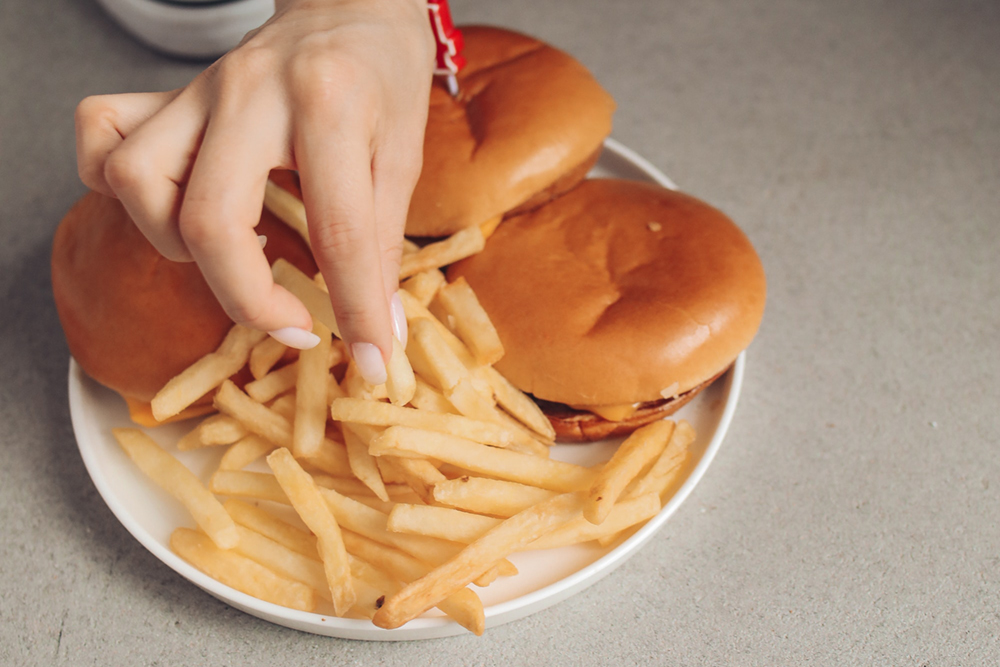
The Surprising Link Between These Foods and Depression, Anxiety and Other Mental Health Issues
Lorie Johnson via CBN News – Macaroni and cheese, hot fudge sundaes, and other comfort foods have become our go-to fixes during the pandemic to help brighten our days and soothe a lonely night. Unfortunately, what’s in these guilty pleasures can make blue moods and other mental health problems worse, not better, as researchers continue to discover a link between what we eat and how we feel.
Mental Health Problems on the Rise
The number of Americans seeking help for depression and anxiety skyrocketed 93 percent in 2020 compared to 2019. While some of that can be blamed on the COVID-19 impact, research shows mental illness has steadily increased for years.
In fact, 40 million Americans deal with some mental health concern. That’s more than the populations of New York and Florida combined. These disorders make the list of the most common causes of death and disability. Suicide scores as a leading cause of death no matter the age group.
Harvard Psychiatrist Uma Naidoo told CBN News, “We need to understand that the silent pandemic going on is one around mental illness – people feeling more depressed, bluer, not sleeping well, feeling extremely stressed and traumatized by everything that’s going on,” she said.
It’s the Food
Meanwhile, three out of four Americans are either overweight or obese – the highest level ever. As it turns out, there’s a link between the skyrocketing weight gain and the sharp increase in mental health problems, according to Naidoo and a growing number of mental health experts. The same foods that trigger weight gain can also lead to depression, anxiety, and other mental health issues.
Dr. Naidoo founded and directs the first hospital-based Nutritional Psychiatry Service in the United States. She is the Director of Nutritional and Lifestyle Psychiatry at Massachusetts General Hospital while serving on the faculty at Harvard Medical School. She is the author of the book, This is Your Brain on Food: An Indispensable Guide to the Surprising Foods that Fight Depression, Anxiety, PTSD, OCD, ADHD, and More.
“The foods that we call comfort foods are actually discomforting for our brain,” she said.
As a result, Dr. Naidoo is one of a growing number of psychiatrists and other mental health professionals using healthy foods to treat their patients.
“Not that a person shouldn’t see their doctor and take medication if they need it,” she explained, “But we also can start today at the end of our fork by making healthier choices in how we eat.”
The Gut-Brain Axis
Dr. Naidoo says a healthy brain begins with a healthy gut.
“Essentially the gut and brain,” she explained. “Even though they are in different parts of the body, they actually arise from the same cells in the embryo and they divide up and turn into these two organs, and then they remain connected throughout life.”
That key connection, the gut-brain axis, is a two-way superhighway sending constant chemical messaging back and forth via the vagus nerve. The chemicals, for better or worse, are determined by the type of bacteria, good or bad, found in the gut.
“When we’re feeding those microbes lots of sugary treats, lots of refined sugars, lots of soda, what unfortunately happens is the bad microbes get fed, and when they get fed sugary foods, they overcome the good microbes,” Dr. Naidoo said.
Sugar Bad, Vegetables Good
Several studies including MRI imaging that shows excessive sugar consumption makes depression and anxiety worse. Dr. Naidoo says processed foods are loaded with sugar, even those that don’t seem sweet.
“Unfortunately things like French fries from fast-food restaurants are actually made with added sugar,” she said. “We don’t taste that, but they’re made to be hyper-palatable. So just be aware of hidden sugars.”
Believe it or not, many fake sugars are just as bad for the gut or in some cases worse than real sugar.
“Several of the artificial sweeteners, unfortunately, can drive anxiety, worsen depression and disrupt those gut microbes,” she said.
Dr. Naidoo recommends adding colorful vegetables, like leafy greens to your menu, which contain folate.
“Folate, when there’s a low level in the brain, actually can lead to depression,” she said.
She advises her patients to load up on antioxidant-rich foods like blueberries and green tea.
“We are combating oxidative stress,” she explained, “Which is really good, and much better for our mental well-being.”
She tells her psychiatric patients to eat plenty of healthy fats like olive oil, avocados, and things like salmon and walnuts which contain high levels of Omega-3 fats.
Not Just Depression and Anxiety
Dr. Naidoo believes in addition to relieving depression and anxiety, that this approach can also have a positive impact on Post Traumatic Stress Disorder (PTSD), Obsessive-Compulsive Disorder (OCD), Attention Deficit Hyperactivity Disorder (ADHD), Schizophrenia, Bi-Polar Disorder and other mental health challenges.
“It doesn’t exclude the use of medications when needed,” she explained, “but it provides individuals with additional tools in their tool kit to really uplift their mental health.”
An added benefit is that a healthy diet can also increase a medication’s effectiveness.
In her book, This is Your Brain on Food: An Indispensable Guide to the Surprising Foods that Fight Depression, Anxiety, PTSD, OCD, ADHD, and More, Dr. Naidoo lists specific foods that alleviate certain mental health problems. She also provides dozens of recipes that address specific mental health challenges.
HERE ARE THREE OF THOSE RECIPES AS FEATURED ON THE 700 CLUB:
Hearty Vegetable Soup
– Fights Depression
This soup has peas for magnesium, broccoli for iron, and sweet potatoes for vitamin A. It is low in saturated fat and high in fiber and antioxidants.
Servings: 4
Prep Time: 15 minutes
Cooking Time: 30 minutes
Ingredients
2 Tablespoons olive oil
1 leek, sliced
1 clove garlic, finely chopped
1 cup fresh or frozen peas
2 cups fresh or frozen broccoli florets
1 sweet potato, unpeeled, cut into 1/2-inch pieces
1 Tablespoon kosher salt, plus more if needed
1 teaspoon black pepper, plus more if needed
1/2 teaspoon dried thyme
1/2 teaspoon dried parsley
4-6 cups hot vegetable stock or filtered water
Fresh parsley, chopped (optional)
Directions
- Heat the oil in a cast-iron Dutch oven on medium heat. Add the leek and garlic and sauté for 3-5 minutes, until the leek is soft and almost translucent.
- Add the peas, broccoli florets, sweet potato, salt, pepper, thyme, and dried parsley and allow to cook, stirring the mixture once or twice for 3-5 minutes. Once the vegetables appear partly cooked, add the vegetable stock. Partially cover, and allow the soup to simmer on medium for about 20 minutes.
- Season to taste with additional salt and pepper if desired, and garnish with fresh parsley, if desired.
Mushroom and Spinach Frittata
– Fights Anxiety
(gluten-free, dairy-free)
This easy-to-make frittata has mushrooms for a vitamin D boost and spinach for magnesium. You could save pieces for lunch for the next 2 days or save for up to 1 month in the freezer.
Servings: 6
Prep Time: 10 minutes
Cooking Time: 18 minutes
Ingredients
5 whole eggs
1 cup almond milk
1/2 teaspoon kosher salt
1/4 teaspoon black pepper
1 1/2 teaspoons dried parsley
1 Tablespoon olive oil
1 cup spinach (fresh or frozen and thawed)
1 cup mushrooms, chopped
Directions
- Preheat the oven to 300 degrees. Line a 9-inch round casserole dish with parchment paper.
- In a medium bowl whisk the eggs with the milk, salt, pepper and parsley and set aside.
- Heat the oil in a medium cast-iron pan over medium heat.
- If using frozen spinach, wrap in cheesecloth (or a clean dish towel or paper towel) and squeeze to remove the excess water.
- Sauté the spinach and mushrooms in the oil until the mushrooms are lightly brown, about 3 minutes. Allow to cool.
- Place the cooled mushroom-spinach mixture in the casserole dish. Pour the egg mixture over the vegetables, cover with foil and bake until the eggs are just set, 15-18 minutes. Ovens vary, so make sure the eggs are set before removing the frittata from the oven. Cut into 6 even pieces and serve.
Chia Pudding Topped with Nuts and Berries
– Fights Trauma
(vegetarian, gluten-free, dairy-free)
Chia pudding is a great way to start the day and doesn’t require any early-morning prep. Since it has to set in the fridge overnight, you can prepare it the night before and then eat on the go.
Servings: 2
Prep Time: 10 minutes
Ingredients
1/2 cup organic canned light coconut milk
1/2 teaspoon honey
1/2 teaspoon vanilla extract
1/4 teaspoon ground cinnamon
2 Tablespoons chia seeds
Raspberries, blueberries, walnuts or other fruit
Directions
- Pour the coconut milk into a mason jar and stir in the honey, vanilla, and cinnamon. Sprinkle the chia seeds on top.
- Screw the lid of the mason jar on and shake well so that the seeds mix with the milk.
- Chill overnight in the fridge.
- Serve topped with nuts and berries.
To read the original article click here.






